On This Page
This page looks at the Seacoast Country Dance Newsletter from a few different perspectives. I present an overview of the newsletter including its history from the perspective of something worth considering on its own. I also look at how the newsletter affected the Seacoast country dance scene over the years.
Click on the tabs to move between sections. Here is a brief description of what is in each tab.
- The Origins of the Seacoast Country Dance Newsletter: How the newsletter got started, with pictures of the earliest newsletter designs.
- The Evolution of the Newsletter, Part I. How the Newsletter responded to changing needs, changing technologies and developing ideas of what should go into it, with more sample pages.
- The Evolution of the Newsletter, Part II. Continuation of Part I; it didn't all fit on one page.
- A Quick History: Some of the Events Covered by the Newsletter. A discussion of some of the dances, festivals, celebrations and other events covered by the newsletter.
- Dance Topics & Issues Discussed in the Newsletter. This is a listing of discussion topics in the newsletter; e.g. evolution of dances and overall dance style over time. Many of the issues mentioned here are reprinted in this website or form the basis for expanded/updated discussion.
Newsletter Origin
The Origins of the Seacoast Country Dance Newsletter
The Seacoast Country Dance Newsletter was started to inform local dancers about upcoming dances. In 1982 I started printing occasional dance calendars to put out at dances, generally covering several months at a time.
At the time there were two dances/month in the Newmarket Town Hall. In the Spring of 1985 a few things happened. First the town built office space in what had been part of the dance hall, leaving a dance space that was marginal given the number of people who generally showed up to dance. Then an accident occurred during a dance in which someone tipped a water table which belonged to the daycare that was sharing the hall. Water dripped through the floor to the police station below. The police weren’t amused by that, and the town stopped allowing us to dance in the hall.
Over the next year and a half the dance was held in a few different places on an irregular schedule.

Seacoast Country Dance Newsletter #2, June 1985. This was the original design.
As soon as we lost the Newmarket Town Hall I started the Seacoast Country Dance Newsletter as a regular monthly publication; the first issue was dated May 1985. It came out on cards that could be mailed and put out at dances. I typed them on a typewriter and brought them to be copied, four to a page, and to have address labels and stamps put on them. At first it only covered local dances along with a paragraph or two news update. There wasn’t that much news and there weren’t that many local dances for a while, so starting with the fourth issue I started listing other dances within an hour or two.
With the March 1986 issue I turned it around to landscape orientation and using the layout of the Maine Country Dance Orchestra Newsletter as a model I was able to list more dances and still have room for a bit of news.
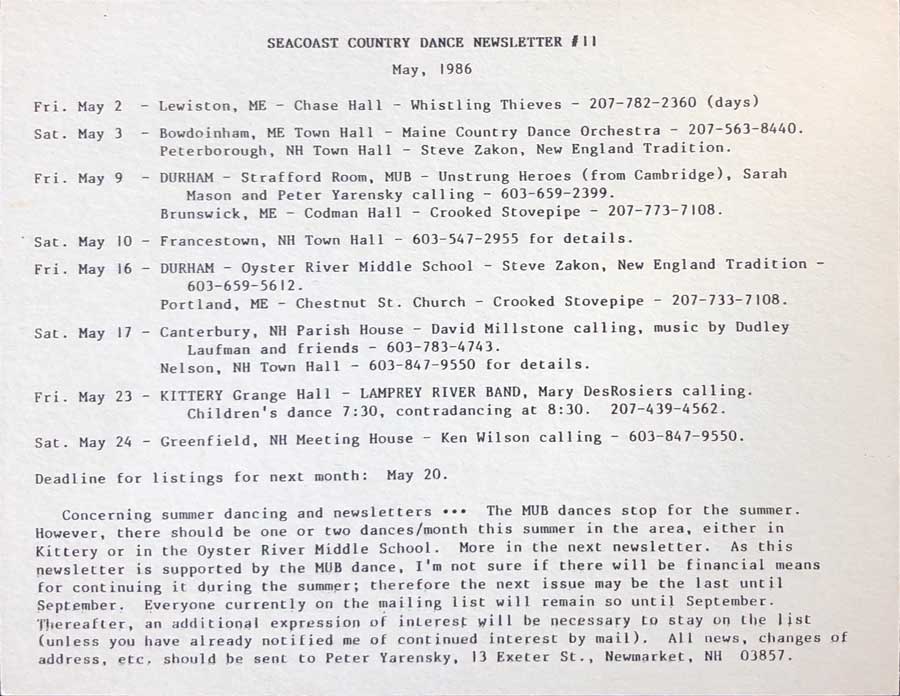
Seacoast Country Dance Newsletter #11, May 1986. This was the first significant modification to the design.
Newsletter Evolution I
The Evolution of the Newsletter, Part I
Icontinued publishing the Newsletter as a card for several months, during which time it got gradually more popular. I was mailing out over 200 copies/month as a free publication, funded from money taken in at Lamprey River Band dances. This was getting too expensive. Around that time I got my first computer, a Mac Plus with an ImageWriter printer. So I decided to redesign the newsletter, print it on 8.5×11 inch paper, and turn it into a subscription newsletter at $5/year. The design fluctuated a bit. The first issue (November 1986) was in portrait orientation. The next one was in landscape orientation on the inside (calendar) page, and the outside had news and comments on the left and on the right a return address perpendicular to the left side and a blank area for the mailing label and stamp. That gave me a page and a half, so I was able to expand coverage of dances and include some commentary as well as news.
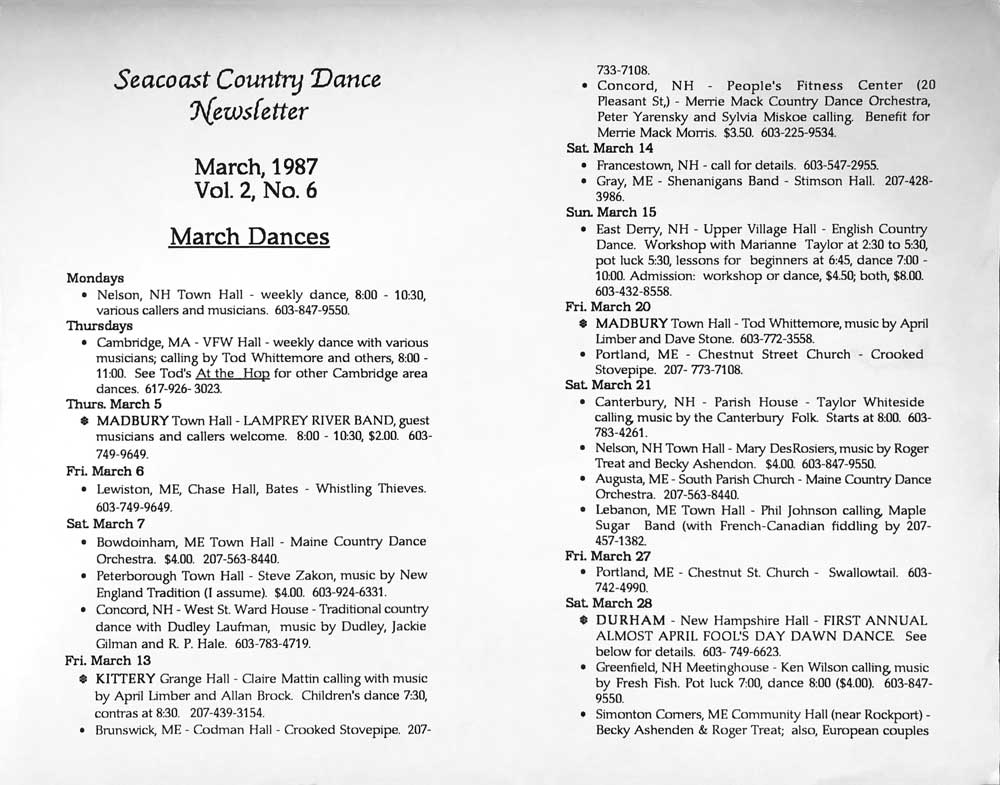
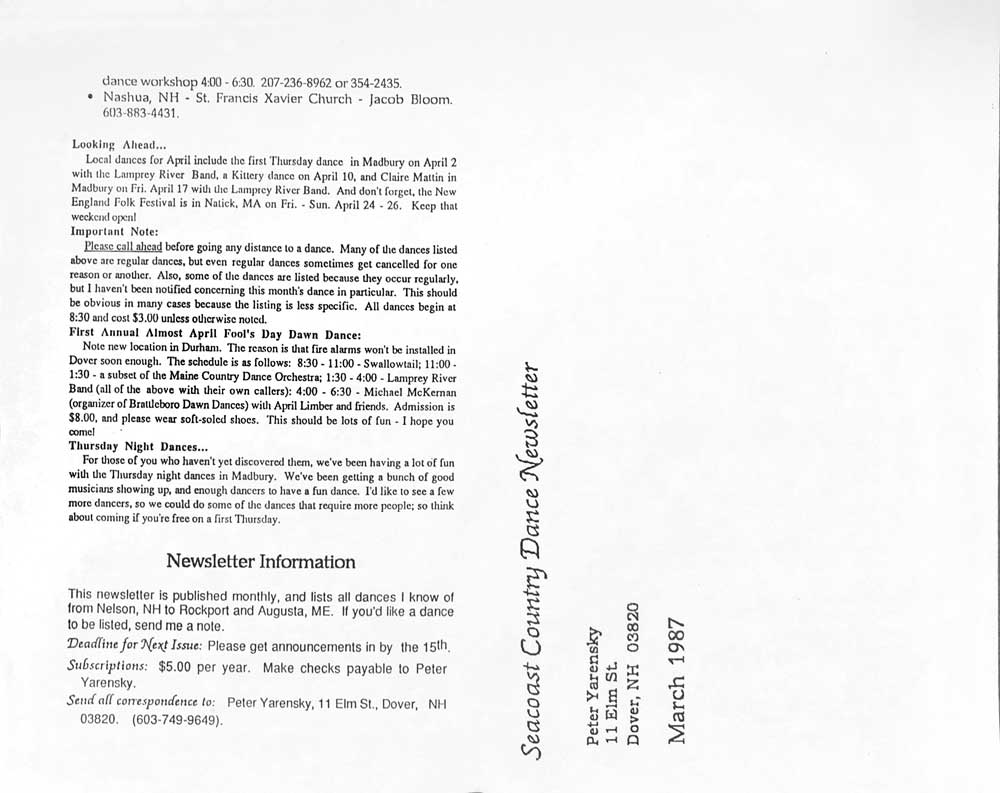
Seacoast Country Dance Newsletter, ImageWriter version (3/87).
The newsletter started out with 55 subscriptions, but by March 1987 it was up to 107, and subscription numbers continued to climb gradually for a number of years.
Several months later the UNH Printing Office got a LaserWriter which members of the university community could use for 25¢/page. I quickly learned how to use it, and starting with the April 1987 issue the Newsletter was printed on a laser printer. I also added in some boxed text on the address section with a newsletter description, subscription and contribution information, Overall it looked much more professional at this point.
With more room I was now including a calendar of most dances I knew of between the Monadnock region and the other side of Bowdoinham. I was also able to include news about upcoming dances, discussion about last month’s dances when of interest, and general commentary on topics relevant to dancing. This allowed the newsletter to become useful not only for calendar information, but to communicate with dancers about topics I thought important.
These included mentioning issues relevant to the dance community, telling people about things happening elsewhere in the area that they might not have known about, discussing dance topics such as phrasing, music and dance style, and more. Thus the Newsletter was able to help form and maintain the community in various ways, and it was useful for expressing ideas and opinions when relevant.
In May 1990 on the Fifth Anniversary of the Newsletter, I switched from using a word processor to a page layout program (ReadySetGo), and I did a major redesign of the newsletter. By current (2020) standards some of the typography was well done, but some of the design reflected that I was just learning to do page layout. Besides the calendar, the sections were clearly laid out: Dance Highlights for the coming month, Concerts, Festivals & Other Musical Events, and then any news and commentary that happened to come up.

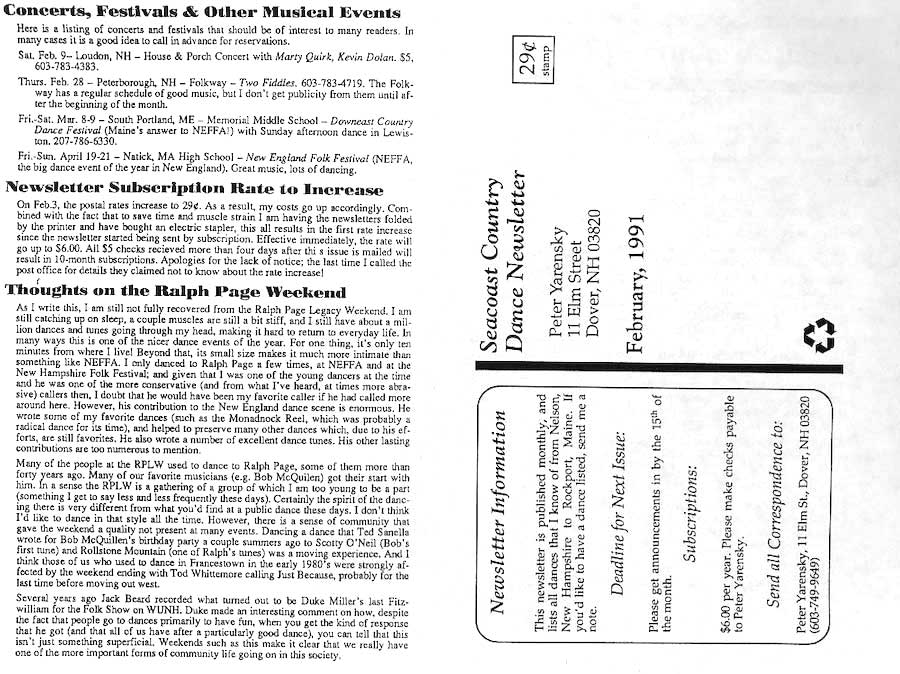
Seacoast Country Dance Newsletter, First page layouot version (2/91).
In March 1991 postage went up from 25¢ to 29¢ and I had to raise the subscription rate for the first time, to $6. There was no apparent change in subscription numbers.
Newsletter Evolution II
The Evolution of the Newsletter, Part II
The biggest redesign of the newsletter came in October 1992, when I switched from letter-sized paper to legal-sized paper. That allowed me to fold the paper in half and have a four-page booklet. It also gave me more room to work with, and made it possible to have an occasional more substantial article. The design now included a sidebar on the front page. The Local Dance Summary made a listing of all local dances with band and caller very easy to see when looking at the newsletter.
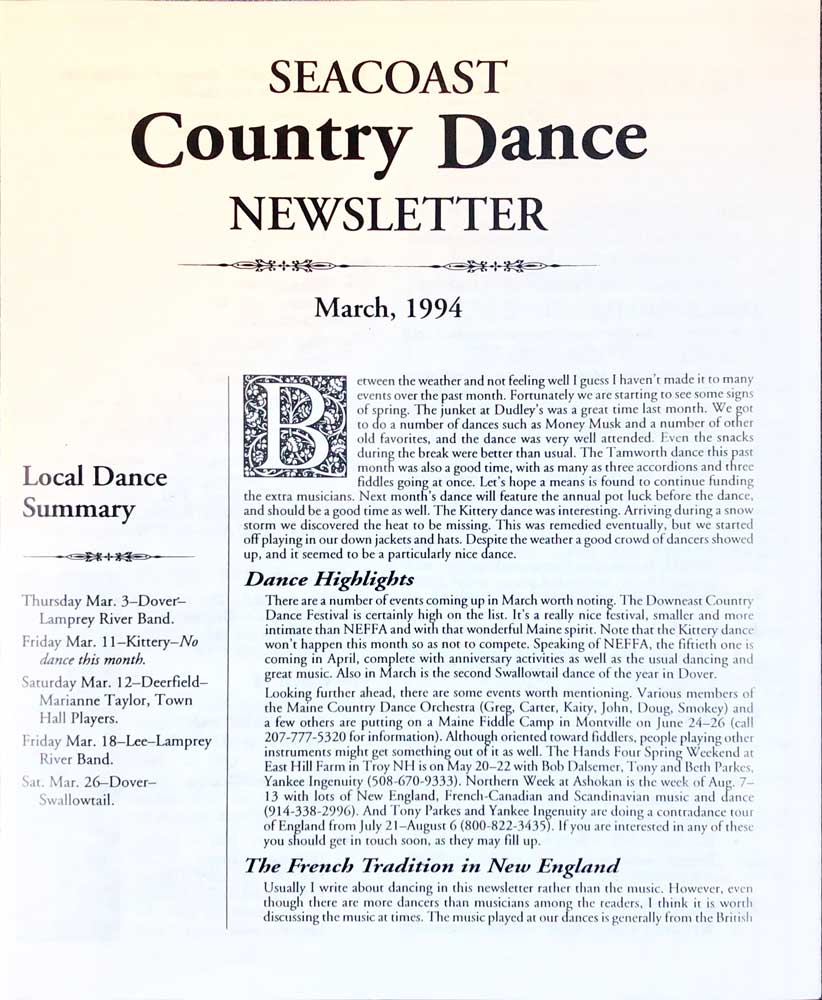

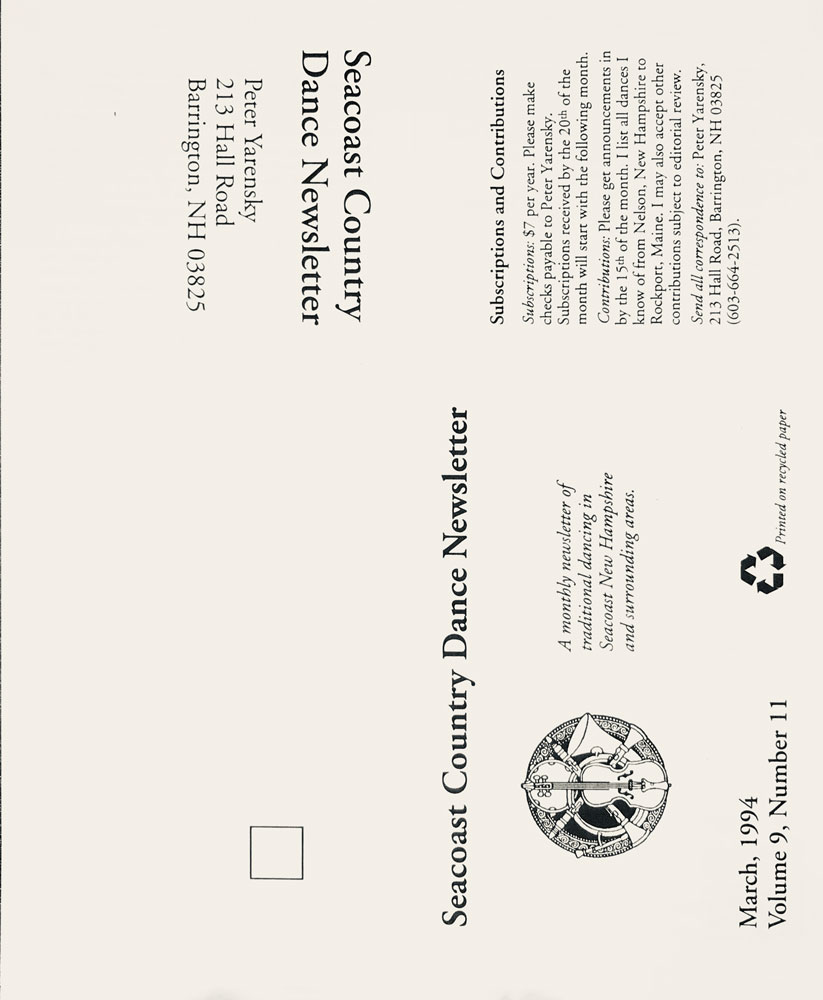
Seacoast Country Dance Newsletter, folded legal size version, 3/94.
At this point the Newsletter started to include more articles telling stories about dance experiences and expressing ideas and opinions about the current dance scene. I got some amount of feedback from dancers, both directly and indirectly, and it appeared to me that the Newsletter was contributing pretty substantially to making the Seacoast dances have more of a community feel than many others, and to making dancers aware of the tradition and of how it was changing.
The Newsletter reached its peak subscription rate in 1993 to 1995, during which it had consistently between 235 and 250 monthly subscribers. In addition, I gave away most of the 60-90 copies printed every month to be put out at dances for free. But during that time the World Wide Web came into existence, and websites were set up with the explicit purpose of letting people know when dances were. As a result, all the newsletters in Northern New England (the others being the DEFFA Newsletter in Maine and the Dance Gypsy in Vermont) were experiencing declines in readership. Actually I’m fairly sure the Seacoast Country Dance Newsletter did better than the others at keeping its readers. That might have been because the newsletter published a number of articles articles that many readers found interesting to read, and also because as a dancer and caller for the biggest dance in the area many of the subscribers were personal friends.
The Newsletter kept going, but it adapted to the times. Subscription rates declined gradually, falling to below 220 in early 1996, but staying mostly above 210 until early 2000. But by mid 2003 they were down to about 150. By then the Dance Gypsy had become a web-only publication. In July 2003 I raised the issue of decreasing subscription numbers and its relationship to people relying more on online sources.


Seacoast Country Dance Newsletter, final design, 11-06, mailed version.
In September 2003 I switched to using InDesign for the newsletter, and along with that did another major revision of the newsletter. The Local Dance Summary disappeared, and the address portion got smaller. This allowed me to increase the type size without decreasing the amount that could be fit into the monthly newsletter. In addition I came up with a second layout for the newsletter on letter-sized paper to be put out at dances. It contained everything in the main newsletter but wasn’t folded and had a simpler layout. It displayed the calendar on the front page, which was useful for people who weren’t familiar with the Newsletter.
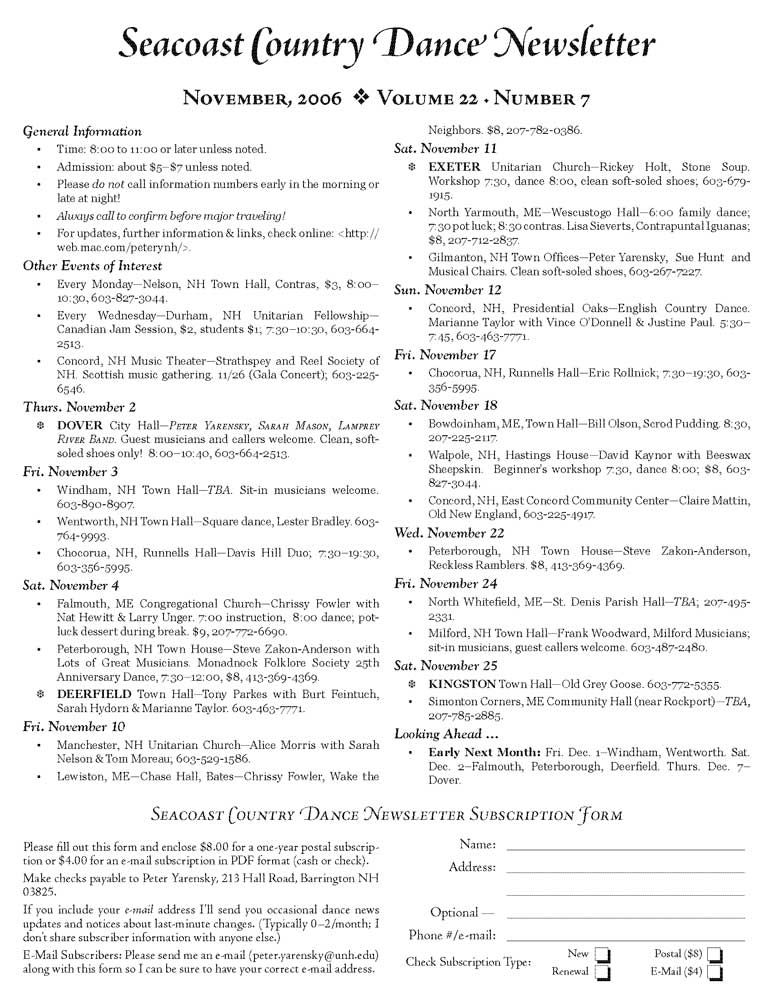
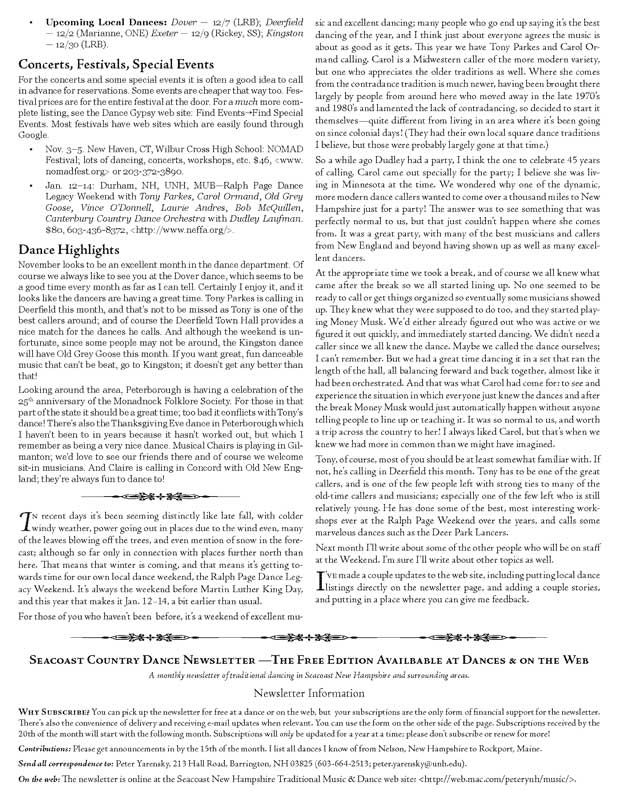
Seacoast Country Dance Newsletter, final design, 11-06, the free version.
The second layout also had the potential to be altered slightly and turned into a version appropriate for email, and in July 2004 I started offering subscriptions in PDF format to be sent out as emails for half price. These proved to be very popular with a moderate number of subscribers. In July 2006 I started working on the last stage of development, putting the newsletter on the web. In September 2006 the newsletter was put on the web. This also allowed me to include expanded versions of some articles on the website and let people know about them in the regular printed and emailed newsletter.
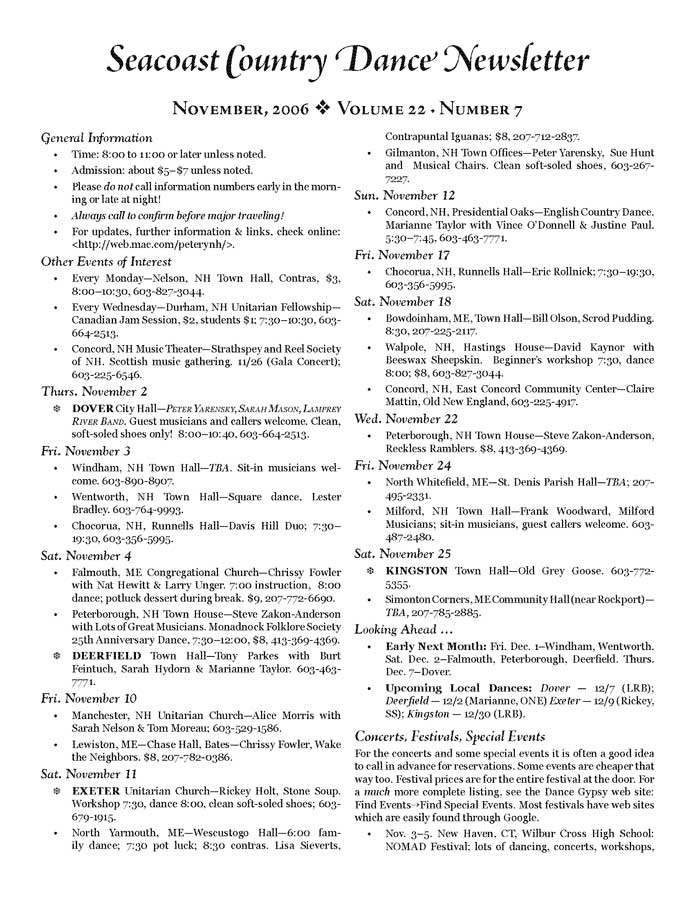

Seacoast Country Dance Newsletter, final design, 11-06, the emailed version.
In the summer of 2007 my father started having major health problems; he died the following summer. As a result I spent much of August 2007 in Connecticut and didn’t get to do my school preparations after having started major revisions to one of my courses. As a result my time for the newsletter went away and never really came back. I kept up the web version and the email version as well as I could, but didn’t get to dealing with the mailed version as well. I got out something most months of 2008, and in 2009 I got out card-sized newsletters covering local dances. I continued doing web updates moderately regularly for a few years, but that was pretty much the end of the newsletter.
Historical Survey of Events Covered
A Quick History: Some of the Events Covered by the Newsletter
This section is based on an article published in the July 2005 issue of the Newsletter. Note: There are probably a few events that were covered in the newsletter of the month listed but actually occurred the previous month. The following is a somewhat expanded version of the original article. Most events are mentioned very briefly. I hope eventually to have an expanded history section which will say more about them.
David Millstone has been after me for some time to send him stories about dancing and dance history in the Seacoast area as part of a project he’s been doing to collect such information from around the country. I didn’t have time during the school year, but now that it’s summer I can do projects like that. It’s been quite an interesting experience looking back over the past twenty years of events, stories, and changes in dancing in the Seacoast area. I started the newsletter after we lost the use of the Newmarket Town Hall which was where most of the regularly scheduled dances were for several years. At that point we didn’t know from month to month when or where the next dance would be, so I started publishing a post card mailed out free to anyone who signed up to let people know where the next dances would be. It was subsidized by dances held in Durham by the Lamprey River Band but as the mailing list grew that became impractical so eventually it became a subscription newsletter in a more ambitious format with more room for stories, news and covering other dances. I thought I’d mention a few of the events that caught my attention as I read through about 350 newsletters in the past few days.
In the early days of the newsletter I covered a couple reunions of the Canterbury Country Dance Orchestra, which with its leader Dudley Laufman is responsible for the current contradance revival: Concord First Night, Dec. 31, 1985 and a concert at the New Hampshire Folk Festival in Concord the following September. Although there was other contra and square dancing happening when Dudley and the Canterbury Orchestra got going in the early 1970s, it was mostly fairly localized. Dudley was an excellent caller, and many of the best musicians in New Hampshire and beyond played with him. The result was a dynamic contradance scene that ended up spreading throughout New England and then to the rest of the country.
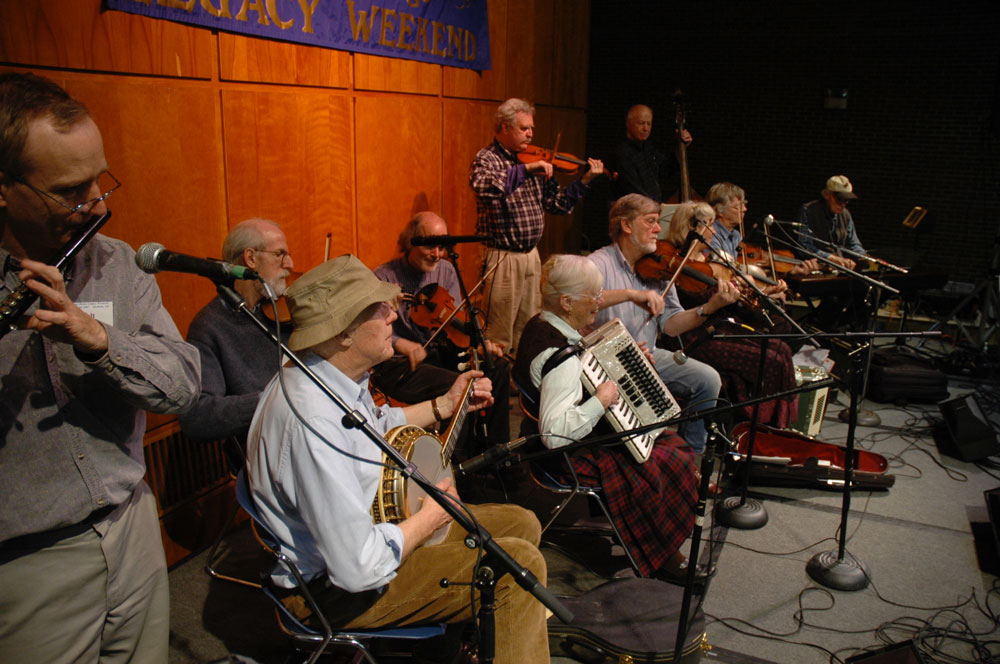
The Canterbury Country Dance Orchestra: a reunion to play for the Ralph Page Dance Legacy Weekend in Durham, 2007. Photo by Patrick Stevens; from the NH Library of Traditional Music & Dance, by permission; see footer for details .
The first Seacoast Dawn Dance at least in recent memory occurred in March of 1987. In August 1987 I announced the Ralph Page Collection moving to the UNH Library. This prompted the first Ralph Page Legacy Weekend in January of 1988. The Lamprey River Band had a big Fifth Anniversary celebration in August of 1988. There were some sad events too, the saddest of which was that Pete Colby and April Limber died in December of 1989; some of us still get very sad thinking about that. To give us something to be happy about, Steve Zakon put on a 76th birthday party in July 1989 for that youngster Bob McQuillen. Although not as final as with Pete and April, Tod’s announcement that he was retiring from calling in the summer of 1990 was very sad for those of us who really enjoyed his dances. Fortunately even though he’s moved away he reappears now and then to call a dance; he’s even going to be at the next Ralph Page Weekend!
In February 1991 there was a big 20th Anniversary party for the band Roaring Jelly. The first Downeast Country Dance Festival was in March of 1991, and for many of us it was the first festival of that sort we’d been to other than NEFFA. What I like the most about it was that it had a real community spirit typical of Maine dances in those days. Unlike more recent festivals, there were a lot of events in which everyone was together, and there were amusing events like the Lady of the Lake Dance contest with all sorts of silly prizes. In December 1991 Steve Zakon put on a party for the re-release of the New England Tradition recording on CD.
The first ever dance on Mount Agamenticus happened in May 1991 and was followed by a few more each year for several years. The first Deerfield dance happened in January 1992. In October 1993 we had the Lamprey River Band 10th Anniversary Dance in Kittery, at which several former band members showed up from around the country and Bob McQuillen showed up to play piano. Then we had the Dover Double Dance with Old Grey Goose and Swallowtail.
In 1994 I announced the first Maine Fiddle Camp, which continues to this day [2020] and has played a large part in bringing fiddling and traditional music to many people in Maine, New Hampshire and elsewhere, including kids, adults, and even people one might think were too old to start playing the fiddle. In September 1994 the first of the current Concord series (now in Boscawen) occurred; I called with the Maple Sugar Band. And at the end of the year there was a party in the Marble Palace in Concord (Dudley’s name for the Historical Society) celebrating the reissue of the Omer Marcoux tune book, and a party for Dudley for 45 Years of Calling. There were actually two callers there who had been calling longer than Dudley: Johnny Trafton and Charlie Webster. October 1995 was the 20th anniversary of the Bowdoinham Maine Country Dance Orchestra dance.

Maine Fiddle Camp, August 2006: A class performance at a Camper Concert. Maine Fiddle Camp attracts people of all ages and abilities.
Ted Sannella died in November 1995. Besides being an excellent caller and composer of dances he was the founder and chair of the Ralph Page Committee. Ted always claimed to be tone deaf. But that didn’t stop him from bringing a well-prepared list of dances to each dance he called, complete with three-tune medleys. Also, at what I’m pretty sure was the 50th anniversary of dancing at the Concord Scout House Ted called dances of 50 years ago, including singing the calls to My Little Girl — which he did very well!
Paul Kanaly had his 90th birthday in February 1996. In April 1996 Donna Maglin died. And in October 1996 Old New England had an album release party in Peterborough. And in February 1997 Crooked Stovepipe had their 20th Anniversary Dance at the State Street Church, at which I called the square dance Crooked Stovepipe. In November 1997 Bob McQuillen got the Governors Arts Award. And in October 1998 Dudley had a party for 50 Years of Calling at the Franklin Unitarian Church with over 300 attending and over 30 in the band. After the break we all lined up, the band started playing Money Musk, and we started dancing; all that happened without any intervention by any caller.
In 1999 I announced the last Buttermilk Hill Old-Time Music Show with great sadness. Held in Belgrade Lakes, ME, it’s always been a day-long festival with all sorts of great music and socializing with friends and maybe some dancing. There was a hint that the younger generation might take it over eventually, and although it didn’t make it into the newsletter, Buttermilk Hill was in fact restarted last summer by the children of the people who got it going in the first place who had so many great memories of it that they couldn’t let it die! [2020 note: For whatever reason it didn’t keep going.]
In December 2000 Paul Kanaly died just short of 95 years old. There was a dance in April in the Kingston Town Hall in his honor. In July 2004 Tod Whittemore called in Peterborough. It was probably his first time calling after his very welcome move back to the area. In June 2005 Larry Jennings died. I wrote more about him in the section on passing on traditions. April 2006 was the last time NEFFA was held in Natick; it moved to Mansfield in April 2007. May 2006 was Dudley’s 75th birthday dance. And in June 2006 Francestown celebrated 60 years of Bob McQuillen’s involvement with dancing; he went to his first country dance in June 1946.
George Hodgson died in February 2007. Jerry Holland got cancer in summer 2007 and died in July 2009. Patrick Stevens died in December 2007, and Marianne Taylor died in August 2008. That wasn’t a very happy time period for the dance community.

Patrick Stevens (closest) dancing at the Star Hampshire Weekend, 2006. Patrick founded the weekend and organized it until he died. He was also chair of the Ralph Page Committee and organizer of the Kittery dance, as well as an outstanding photographer.
During the time I’ve been publishing the newsletter we’ve lost many halls which is a perpetual problem, and various dances have begun and ended. The Newmarket dance goes on though; it’s now the third Friday Kingston dance. We’ve also lost many dancers and musicians, some of whom like Paul Kanaly, Wilson Langlois and Phil Johnson died. Those of us who have been dancing for a while still remember them.
But the other side of it is that we have many new people in our community; many of the young dancers that came to the Dover dance this spring [2005] weren’t even born or were quite young when I wrote the first issue of this newsletter in May of 1985. And in 2020 I’ll add that many new dancers continue to come to the dances, some of whom were quite young or not born yet when I wrote the article in 2005 on which this is based. As I write pretty much all dancing and nearly everything else is on hold; but hopefully the time will come again fairly soon when we resume this wonderful activity.
Dance Topics & Issues
Dance Topics & Issues Discussed in the Newsletter
Here is a listing of some of the dance-related topics and issues that I discussed in the newsletter over the years. Some of these were longer articles and some were just a few paragraphs. There were others as well, but this list contains most of the more major articles and discussions. Some of these are on tis website either on their own or as part of another topic; I try to identify them when they are used.
- Some Thoughts About the Dances We are Dancing (3/88). Based on a couple experiences with people using different phrasing for Money Musk I discussed the changes in phrasing of that, Petronella and French Four, all of which involved in some way speeding up the pace of the dance
- Dancing to the Music I: Introduction (2/89). Based on comments from dancers that there were problems with dancing to the phrase I described the structure of a tune, phrasing, and how figures like walking steps and a balance fit the phrasing.
- Dancing to the Music II: Down the Center Two By Two (3/89). This looked at the figure "down the center and back, cast off" and analyzed how one would break up the 8 bars (16 counts, or 16 steps) to complete the figure in the allotted time.
- Dance Style Notes (8/90). Commentary on reaction of some male dancers to a dance called with a same-sex dance, and my observations about the lack of polish in most mens' swings.
- Why We're Living in the Right Place (1/91). Observations based on experiences at a Greenfield NH dance about how at most dances there are musicians and dancers dancing who could fill in if necessary and who are likely to sit in; which wouldn't happen i many other places. It may be cold in the winter, but New Hampshire is a great place to live if you're a contradancer.
- A Trip to Ashokan (9/91). A report on my first time at Ashokan, and my first time at a music and dance camp. I enjoyed the classes, the people and everything else much more than I was expecting.
- Thoughts on the World of Contradancing (5/93). Four-part series discussing the rise of Western square dancing and whether the increased speed and complexity of dances reflected a similar development in the world of contradancing.
- The French Tradition in New England (3/94). About French Canadian fiddling in New England, and some discussion of the playing of Marcel Robidas at dances.
- Thoughts on the Development of Traditional Dancing (2/95). Five-part article run between February and August 1995 looking at some of the changes in dancing over time and some of the possible reasons for those changes.
- Sound Levels at Dances (6/96). An untitled discussion of the increasing frequency of excessively loud sound at dances, reasons for it to occur, and what one can do when the problem arises.
- Younger People at Dances (3/98). An untitled discussion of the increased participation by younger people, and likely effects on the dancing.
- Variety of Dances Available (11/00). An untitled discussion of the variety of dances to be found, and a discussion with Larry Jennings about how that wasn't always the case, which was what prompted him to invent modern-style contradancing.
- Herbie Gaudreau, Becket Formation and the Development of Equal Dances (9/02). An untitled discussion of Herbie Gaudreau's contributions to the development of modern contradancing. He developed not only Beckett formation, but equal dances in which actives and inactives did the same thing. Interestingly he was unable to come up with an equal dance in regular contra formation with a swing.
- Younger People At Dances (11/03). An untitled discussion of the effects younger people will have on dances and how this is something that happens with each new generation.
- Money Musk (8/06). A discussion of how the forward and back seems to be drifting in many places to a balance side to side.
- A Look at Local Dances (3/08). An untitled discussion of the importance of local dances and a look at some of the local dances around New Hampshire.
